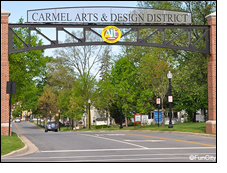Subscriber Benefit
As a subscriber you can listen to articles at work, in the car, or while you work out. Subscribe NowThe city of Carmel’s huge investment of public dollars into its central core has paid off when it comes to generating economic activity, jobs and additional investment in the area, according to a study released Monday by the IU Public Policy Institute.
The report, which the city paid the institute $92,000 to conduct, examines the city’s redevelopment strategies since 1995 and provides an overview of the redevelopment process, investments made, outcomes of those investments and lessons learned by local officials.
The results of the study concluded that Carmel—and specifically Mayor Jim Brainard—have earned a reputation for taking a proactive approach to redevelopment and those efforts resulted in hundreds of millions of dollars of private investment, assessed value growth and job creation.
“In summary, the type of mixed-use development within the City Center and the Arts & Design districts, relatively dense housing, apartments/condos and townhomes, with office and retail, is a fiscally-responsible development style,” the report stated, explaining that the approach reduces the cost of municipal services such as public safety, stormwater, roads, solid waste collection, wastewater and water, and school transportation.
Researchers did acknowledge that the project was "not without disagreement over the development process and concern regarding Tax Increment Financing as a funding source, among other issues."
The research focused on the core of the city, stretching from Smokey Row Road to Carmel Drive and from Third Avenue SW to Fourth Avenue SE. It included the areas of City Center, Midtown and the Arts & Design District.
The report, authored by Public Policy Institute researchers Drew Klacik and John Marron, concluded that Carmel’s public investment in the area was necessary to achieve the results, despite drawing a number of local opponents to the spending decisions.
“The market, while favoring Carmel, would not have delivered dense and vertical development with integrated mutlifamily housing, retail and restaurant development,” the authors wrote. “Instead, the market would have continued to isolate single-family housing from retail, restaurants, and office development.”
The study also noted that researchers couldn’t find any examples of dense new urban development occurring in other nearby suburbs without “significant public participation.”
According to the 26-page report, Carmel invested about $174 million in infrastructure and facilities from 1995 to 2014, which resulted in an additional $110.2 million of economic activity within the county.
In other words, for every dollar Carmel spent, it generated 63 cents of new economic activity.
On top of that, more than 3,330 jobs are attributed to the investment in the researched area, resulting in $140 million in employee compensation. And more than $150 million in new single- and multifamily housing construction occurred in the neighborhoods surrounding City Center and the Arts & Design District.
Job growth in the City Center area wasn't as strong as in the entire city or county—increasing 13.2 percent from 2004 to 2011, compared with nearly 24 percent in the city and 34.7 percent in Hamilton County. However, the number of residents in the City Center area with jobs increased 43.8 percent in the same time frame, a rate higher than the 8.7 percent rise in Carmel and 16.2 percent in the county.
The redevelopment strategy started just before Brainard took office in 1996, as the city’s 11-acre government center with City Hall, the police department and fire department opened.
In 1997, the Carmel Plan Commission completed a comprehensive plan that estimated all of the city’s land would be developed by 2020 and the population would reach 85,000.
The population has already hit 86,946, according to the results of a special census, and only 2 percent of the land in the studied area remains undeveloped—down from 10 percent in 2004 and 23 percent in 1994.
City Center has been slowly progressing since the late 1990s when public conversations about the project started. The first building for the Carmel Bike Shop started construction in June 2001.
Since then, several other multistory and mixed-use buildings have opened, including The Nash, the Center for the Performing Arts, the headquarters for Pedcor Cos. and The Mezz.
Between 2004 and 2014, 565 building permits were issued in the researched area, and the taxable assessed value growth “greatly outpaced downtown developments in other communities,” according to the report.
And work at City Center continues today. The nearly $14 million Park East garage is under construction, along with the 64,000-square-foot Baldwin/Chambers mixed-use building and 20,000-square-foot Pedcor office building.
There’s also still more to come in the Arts & Design District. Chuck Lazzara, owner of the event services company and venue Ritz Charles, and his son, Anthony, are pursuing a $20 million mixed-use development on the southwest corner of Main Street and the Monon Trail, called Monon & Main.
And work is under way on Midtown, a development between City Center and the Arts & Design District that was only in the planning stages during the time of the study. Work also has begun on the five-story, 135,000-square-foot Allied Solutions headquarters as well as the 580-space parking garage that will connect to the office building.
“While the project is yet to be completed and final outcomes determined, the early returns indicate that Carmel has successfully built a national reputation for itself and is positioned to gracefully transition along with the changing tastes of millennials and boomers,” the authors wrote in the report.
Please enable JavaScript to view this content.
